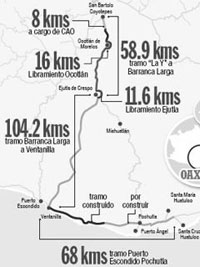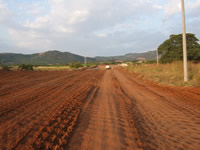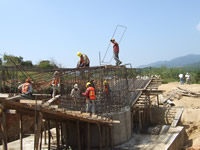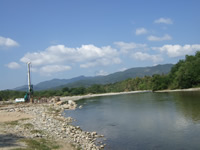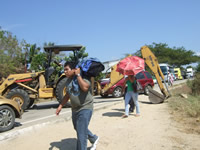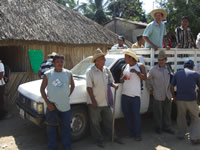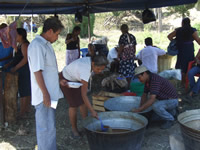Highway 2012
“What do the local people think about the new highway to Oaxaca?” Jorge Román, an engineer with the Omega Group, which is responsible for getting most of it built, asked. “Well”, I replied, “we won’t believe it until we see it.”
While not exactly the Panama Canal or the Chunnel, the new Puerto Escondido-Oaxaca highway is a major project with its own unique challenges. The first 11 kilometers which runs from the Coastal Highway in Ventanilla, Santa María Colotepec, involves building bridges, diverting streams, and cutting the top off a mountain, and this is just in the foothills of the mountains the highway will eventually cross. The bridge currently being built over the Colotepec River, a few kilometers south of the town of Colotepec, will be the longest. The Grupo Omega, a privately held Mexican company owned by the brothers Juan and Jorge Melgarejo Haddad, won the concession for building a 104.2 stretch of toll road - from Ventanilla, Santa María Colotepec to Barranca Larga, Ejutla in 2008. Omega was to begin construction in April 2009, but it received two postponements from the Department of Communications and Transportation (SCT) when it was not able to get financing due to the international banking crisis of that year. Construction in Ventanilla actually began in June 2010. According to the terms of the concession, the highway must be completed in 24 months from its inception. The concession gives Omega a 30-year participation in the income from tolls. Omega has subcontracted construction to various teams of engineers, each group responsible for a different section of the highway but all under the supervision of Omega engineers. However, not all the sections are being worked on simultaneously. Four tunnels - from 120 to 150 meters in length - are also part of the project.
Will we be able to drive to Oaxaca in two hours in June of 2012 as José Luis Chida Pardo, director general of the Oaxaca SCT, announced last June.? Will we be able to afford the tolls? Will what’s being called the Puerto Escondido-Huatulco corridor be the next Mayan Riviera? One day international travelers will be able to fly into Oaxaca and be in Puerto is just a couple of hours; but I wouldn’t make my travel plans just yet.
Then there is the problem of widening 15 kilometers of highway 200 between Puerto and Pochutla. The expansion of the free coastal road connecting Puerto to Huatulco is also part of the federal project. The residents of San Francisco Cozoaltepec, Tonameca say they were never indemnified when the present 2-lane highway was built in the 1980s. This farming community of 2,400 inhabitants blocked the highway for a few days in January 2010 to press their claim.
The situation got more complicated later in the year when a check for 10,2000,000 pesos (U.S. $1,000,000) from the Oaxaca Department of Communications and Transportation (SCT) to indemnify the land office (bienes comunales) bounced when they took it to the bank. The SCT had stopped payment when another group claimed the money should go to them. The comuneros also accuse the SCT of sitting on these federal funds for two years so that it could collect 10 million pesos in interest. The conflict led to the highway being blockaded for over a week in November coinciding with the anniversary of the Mexican Revolution.
When these photos were taken on Tuesday, November 16, the seventh day of the blockade, the road had been closed since 8 pm on Monday. Traffic was later allowed to procede for around an hour, starting at 1 p.m. The drivers seemed to take the delay in stride. The local people brought them food and water, and they rested or socialized in the shade of their trucks. There were even porta-potties. Airport vans from Huatulco were able to leave passengers on one side of the barricade to be picked up by another van on the other side. Other travelers took local buses and then had to walk a few hundred meters to wait for another bus.
If the truckers were philosophical (“We’re being held hostage in a conflict in which we play no part,” one said.) and good humored, the protesting farmers were not. They were tired and grim. “This is our land,” said a protester, pointing to the highway.
Was tourism in Puerto affected? Probably, but then again everything affects us. Earlier in November there was a different blockade on the highway in Pinotepa Nacional stopping traffic to and from Acapulco. On September 25 of this year there was a terrible storm that washed away two lanes of the Coastal Highway above the Adoquin sending a mountain of mud into restaurants on the tourist strip.
The loss of Mexicana Click flights in August to what used to be our international airport continues to affect both national and international tourism, which was just recovering from last year’s flu epidemic. And of course there’s the recession, and the dollar and the euro both falling in November relation to the peso, making Mexico in general less attractive to foreign tourists.
The typical Puerto response to all these problems is a little frown and then a big smile - we, after all, are lucky enough to live here. We know the highway isn’t being built to allow us to get to Oaxaca in two hours, but rather to bring visitors to our beautiful beaches.by Barbara Joan Schaffer

